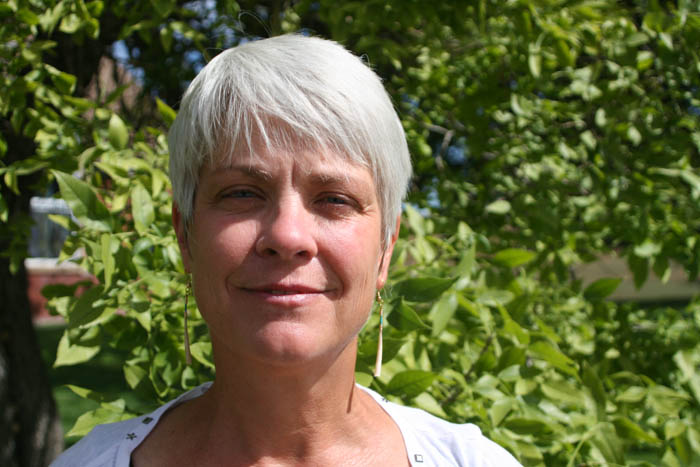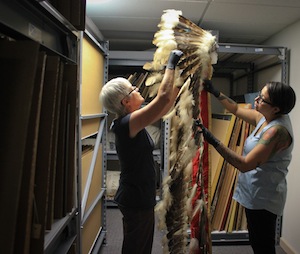Preserving a Heritage Art Collection in Isolation
posted on January 3, 2014
 Alongside treasured Native artifacts from the Great Plains and beyond, Mary Maxon’s office is filled with magnifying glasses, cameras, cardboard boxes, hot glue guns, and q-tips. As The Heritage Center’s Collections Manager, she spends her days preserving and maintaining its massive, 10,000-piece collection of Lakota and other Native art, nestled in the rolling hills of the Pine Ridge Indian Reservation, more than 100 miles from Rapid City, SD.
Alongside treasured Native artifacts from the Great Plains and beyond, Mary Maxon’s office is filled with magnifying glasses, cameras, cardboard boxes, hot glue guns, and q-tips. As The Heritage Center’s Collections Manager, she spends her days preserving and maintaining its massive, 10,000-piece collection of Lakota and other Native art, nestled in the rolling hills of the Pine Ridge Indian Reservation, more than 100 miles from Rapid City, SD.
On any given day, you can find her standing hovered over a historic headdress or a painting by an up-and-coming Native artist, surrounded by shelves of archival equipment, tools, cataloging essentials, ready to care for the artwork before her.
The Heritage Center’s collection has been recognized nationally and internationally for its extraordinary representation of Lakota historical items and contemporary Native art, despite its geographical isolation. It includes a range of unique pieces, from elaborate historic regalia and complex contemporary art. And each is handled with the utmost care, explains Mary.
“We handle each and every item with meticulous care and respect, and in an effort to preserve it for as long as we possibly can,” she says.
Properly managing a collection of this size and scope is a unique challenge for The Heritage Center, a small nonprofit cultural and community center located on the Pine Ridge Reservation. Mary is the only person on staff who focuses exclusively on caring for and preserving the collection. And when she’s not involved in preservation, she’s doing the work of organizing and cataloging the collection, documenting items in Mimsy, The Center’s digital database.
The work, she says, isn’t always glamorous—but it's crucial to ensuring the collection will be accessible to those who love and appreciate Native art, including generations of local families whose culture and heritage the collection represents.
“I really spend a lot of time wrapping and boxing items for both storage and shipping. Then I store the items, or ship them, or drive them to where they need to go. I do a lot of record keeping and spend a lot of time with a camera, and a database, so that we know where and how everything is stored. It’s what’s necessary to keep the collection safe and protected, as well as accessible to the public.”
 Mary has worked in museums for over 25 years working in numerous roles and a variety of institutions, from the Field Museum of Natural History in Chicago to the Idaho Museum of Natural History to the Dahl Arts Center in Rapid City. She’s also been a sculptor, mount-maker, installation supervisor, exhibit developer and a graphic designer. She says her experience with a broad range of artistic mediums and collections informs her work every single day.
Mary has worked in museums for over 25 years working in numerous roles and a variety of institutions, from the Field Museum of Natural History in Chicago to the Idaho Museum of Natural History to the Dahl Arts Center in Rapid City. She’s also been a sculptor, mount-maker, installation supervisor, exhibit developer and a graphic designer. She says her experience with a broad range of artistic mediums and collections informs her work every single day.
It has also helped her overcome the challenges of preserving a collection that is geographically isolated. The Heritage Center, which sits on the campus of Red Cloud Indian School, is a two-hour’s drive from any major urban area, which makes Mary’s preservation work more complex.
“It’s challenging, but you have to prepare in advance and know that it’ll take time to get supplies and things you need to work with. It makes it more difficult to connect with both supply and information.” She says that something as simple as traveling to purchase a box of sheet protectors might require a four-hour trip.
To meet the challenge of distance, Mary uses online resources to communicate with professional peers and suppliers to stay connected to the outside art world. She uses virtual tools to attend meetings and trainings, and to share updates about The Heritage Center’s work.
“While it is sometimes challenging to communicate effectively through digitally-shared pictures and emails, at least it is possible,” she explains.
Although the Center’s location sometimes creates obstacles, Mary believes that being on Pine Ridge is a critical part of The Heritage Center’s identity—and she wouldn’t have it any other way.
“To me, it’s incredibly important that we are preserving the only collection of its kind to be housed on a reservation,” says Maxon. “We offer our community the opportunity to view and study works of art that represent their own culture and history, right here on Pine Ridge. It’s something I’m very proud to be a part of.”
All Content, ©Red Cloud Indian School, 2014
